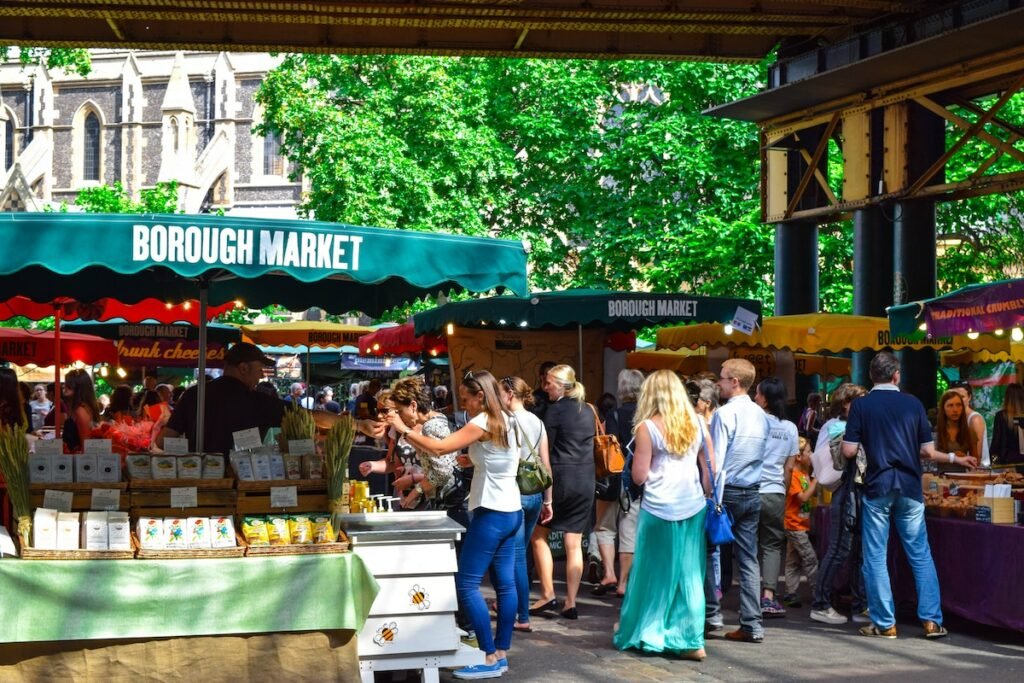One of the most delightful aspects of traveling is savoring the local cuisine. Yet, distinguishing between authentic local eateries and tourist traps can be a culinary challenge. Follow these savvy tips to ensure your taste buds embark on an authentic gastronomic adventure:
1. Research Ahead of Time

Effective pre-trip research can be your compass to authentic dining experiences. Leverage travel apps, blogs, and forums to compile a list of local favorites and highly-rated restaurants. Delve into reviews and recommendations from fellow travelers, absorbing their firsthand experiences and insights.
This preparatory work not only helps you locate hidden culinary gems but also equips you with a menu of options to fit your taste preferences and dietary requirements. Armed with knowledge, you’ll confidently navigate the culinary landscape of your destination, ensuring that each meal is a flavorful journey into the heart of the local food culture.
2. Wander Off the Beaten Path
Venture away from the main tourist areas and explore the side streets and neighborhoods where locals live and dine. You’re more likely to find authentic eateries away from the crowds.
3. Ask Locals for Recommendations
One of the best ways to unearth authentic dining treasures is by seeking guidance from the very people who call the place home. Locals are invaluable sources of culinary wisdom. Strike up conversations with residents, whether it’s your hotel’s concierge, a shop owner, or a friendly passerby.
Their recommendations often lead you to hidden gems and cherished neighborhood eateries that may not be on the tourist radar. Beyond just discovering great food, these interactions offer a unique window into the local culture, fostering connections and memorable experiences that define the essence of travel.
4. Follow the Crowd

If you see a restaurant bustling with locals, it’s usually a sign of good food. Trust the wisdom of the crowd, and be patient if you have to wait for a table.
5. Check for Menus in the Local Language
A menu in the local language is often a sign that the establishment caters to locals. It’s a good indicator that you’re in for an authentic dining experience.
6. Avoid Restaurants with Picture Menus
When it comes to finding authentic food while traveling, one telltale sign that a restaurant might cater primarily to tourists is the presence of picture menus. While it’s understandable that visuals can be helpful, especially when you’re in an unfamiliar place, here’s why you might want to avoid such establishments:
1. Quality Concerns: Restaurants that rely on pictures to sell their dishes may prioritize appearance over taste and authenticity. The emphasis is often on creating photogenic meals rather than focusing on the true flavors of the local cuisine.
2. Limited Variety: Picture menus tend to feature a small selection of dishes, typically the ones that are easiest to photograph. This can limit your exploration of the local culinary scene, as many hidden gems might not make it onto the menu.
3. Tourist Pricing: Such restaurants often charge higher prices for dishes that may not be as flavorful or genuine as those found in local eateries. Tourist areas are notorious for inflated prices, and picture menus can be a red flag in this regard.
4. Loss of Cultural Experience: Part of the joy of traveling for food is immersing yourself in the local culture. Dining in restaurants where locals eat allows you to experience the authentic atmosphere, interact with locals, and learn more about the culinary traditions of the region.
5. Risk of Disappointment: Relying on pictures can sometimes lead to disappointment. What looks enticing in a photo might not live up to your expectations in terms of taste and quality.
6. Missed Opportunities: By sticking to restaurants with picture menus, you might miss out on incredible, off-the-beaten-path spots that offer unique and unforgettable dining experiences.
While picture menus aren’t an absolute guarantee of a negative dining experience, they can serve as a cautionary sign. When you’re on the hunt for authentic cuisine, consider exploring places that provide detailed descriptions in the local language or that have menus without pictures. These establishments are more likely to prioritize the culinary heritage and flavors that make your travel experience truly memorable.
7. Embrace Street Food

When it comes to discovering the heart and soul of a destination’s culinary scene, few experiences rival indulging in street food. Street food vendors are often the unsung heroes of a city’s food culture, serving up authentic flavors and beloved local specialties. Here’s why you should wholeheartedly embrace street food during your travels:
1. Authenticity and Tradition: Street food is a direct reflection of local culture and traditions. It’s the food that people in the area have been enjoying for generations, prepared with recipes passed down through families.
2. Budget-Friendly: Street food is typically affordable, making it an excellent option for travelers on a budget. You can savor mouthwatering dishes without breaking the bank, allowing you to try a variety of foods during your trip.
3. Freshness and Flavor: Street vendors often source their ingredients daily from local markets, ensuring freshness and quality. The result is food bursting with flavor, as many street chefs are experts at infusing their dishes with a rich blend of spices and seasonings.
4. Cultural Immersion: Dining at street food stalls immerses you in the daily life of locals. You’ll likely find yourself sharing communal tables, striking up conversations with fellow diners, and gaining insights into the local way of life.
5. Variety: Street food offerings are incredibly diverse, ranging from savory to sweet, and spanning a wide range of cuisines. Whether it’s tacos in Mexico, pad Thai in Thailand, or churros in Spain, there’s a world of flavors to explore.
6. On-the-Go Convenience: Street food is designed for on-the-go consumption. It’s perfect for travelers who want to maximize their time exploring rather than sitting in a restaurant.
7. Adventurous Eating: Street food often includes unique and adventurous dishes that you may not find in conventional restaurants. Trying these local specialties can be a memorable part of your travel experience.
8. Authenticity Guarantee: Locals often flock to street vendors because they know they’re getting genuine, time-tested recipes. If the locals are eating there, it’s a good indicator that you’re in for a treat.
9. Food Safety: While hygiene is a concern, street food vendors who cater to a steady stream of customers tend to prioritize cleanliness to maintain their reputation. Look for vendors who prepare food on the spot, use gloves or utensils, and have a visible food-handling process.
10. Sustainability: Many street food vendors use minimal packaging, reducing waste compared to sit-down restaurants. This aligns with the growing trend of sustainable and eco-friendly travel.
To make the most of your street food adventure, don’t be afraid to ask locals for recommendations. They’ll likely be more than happy to point you in the direction of their favorite stalls and dishes. Additionally, be open to trying new things and expanding your palate, as street food can introduce you to flavors and culinary traditions you won’t find anywhere else. Embracing street food is not just about eating; it’s about connecting with a place and its people through the universal language of food.
8. Seek Out Local Markets
Visit local markets to sample fresh, seasonal produce and regional specialties. You’ll also find food stalls serving traditional snacks and meals.
9. Use Food Tours
Consider joining a food tour led by a knowledgeable local guide. These tours can introduce you to authentic flavors and provide valuable insights into the culture through food.
10. Trust Your Senses
Use your senses to gauge authenticity. The aroma of freshly cooked dishes, the presence of locals, and the use of traditional ingredients can all be indicators of authenticity.
11. Avoid Places with Aggressive Touts

While exploring a new destination, you might encounter places with aggressive touts or hawkers attempting to lure you into their restaurants. It’s essential to exercise caution in such situations for several reasons:
1. Pressure Tactics: Aggressive touts may use high-pressure sales tactics to convince you to dine at their establishment. They may exaggerate the quality of their food or offer unrealistic discounts to draw you in.
2. Quality Concerns: In many cases, restaurants that rely on touts don’t prioritize the quality of their food. Instead, they focus on attracting as many customers as possible, often at the expense of the dining experience.
3. Overpricing: Touts may not always provide accurate information about menu prices, leading to unpleasant surprises when you receive the bill. This can leave a dent in your budget.
4. Inauthenticity: Such places are more likely to cater to tourists, often serving generic dishes that lack the authenticity and flavors you’d find in local eateries.
5. Discomfort: Dining at a restaurant where you felt pressured to enter can detract from your overall dining experience, leaving you feeling uncomfortable and rushed.
To avoid falling into the trap of aggressive touts, politely but firmly decline their offers and continue exploring. Instead, rely on the tips mentioned earlier, such as seeking recommendations from locals or using reputable travel apps, to find authentic and enjoyable dining experiences that align with your preferences and budget.
12. Learn Basic Phrases
Learning a few local phrases or food-related words can go a long way. It not only helps you communicate your preferences but also shows respect for the local culture.
13. Embrace the Adventure
Finally, be open to culinary adventures. Trying new foods, flavors, and dishes is what travel is all about. Don’t be afraid to step out of your comfort zone.
Differentiating between local eats and tourist traps requires a blend of research, local insights, and a willingness to explore. By following these guidelines, you’ll be well on your way to savoring authentic, mouthwatering cuisine that embodies the essence of your travel destination.
For authentic, local cuisine, choose Tiburon Tavern! Contact us at 628.226.9547 to make reservations or to inquire about reserving our space for an upcoming event.
